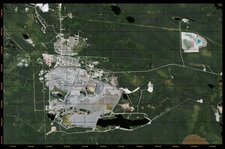Canadian Malartic Disseminated Au Deposit

Site Sponsor: Mine Canadian Malartic (Agnico-Eagle and Yamana Joint Venture) Website
Site Leaders: Robert Linnen, Gema Olivo, and Anthony Williams-Jones
Research Associate: Stéphane Perrouty
Research Scientist (Part-Time): James Clark
PhD Candidates: Charles Lafrenière-Bérube, Noémi Fayol, Nicolas Gaillard
MSc Candidates: Sandra Beauchamp, Kun Guo, Philip Lypaczewski, Nicolas Piette-Lauzière, Thomas Raskivicius
Summer Field Assistants: Guillaume Clouette-Gauthier (2013), Nicolas Piette-Lauzière (2013)
Most large Archean gold deposits occur in deformed greenstone terranes in proximity to long-lived, major compressional to transtensional crustal-scale fault zones. At the local scale, the gold deposits are controlled by secondary structures, are spatially associated with various generations of intrusions, and exhibit a variety of mineralization styles. Many detailed studies have been conducted at the deposit scale, but much uncertainty remains in the exploration models, particularly for mineralization associated with intrusive rocks, but only a few investigations have addressed the camp-scale footprints of orogenic gold systems and what vectors can be applied to mineral exploration within those footprints. This poses major challenges for regional exploration programs, especially for large-tonnage low-grade deposits that are currently being sought. Such deposits can reflect a complex interplay between primary or secondary permeability of the host rocks, and fine to coarse brittle fracturing due to faulting and intrusive activity at the camp scale. The exploration challenge in these deposits is to recognize the significance of the outer, non-mineralized alteration systems, and to develop a variety of indicators (lithogeochemical, mineralogical and geophysical) that can be combined to vector towards the mineralized center. Effective exploration is also challenged by the considerable variability in the styles of mineralization, structural and lithological controls, geometries of the orebodies, and the mineralogical and geochemical characteristics of ore and alteration (proximal and distal) within a single district, and the apparent lack of distinct geophysical signatures.
Several fundamental questions need to be addressed to improve the footprint model of this deposit type. How can we distinguish the critical structures that control the mineralization at the camp and deposit scales from other elements in the architecture of a district? What is the genetic relationship between mineralization and possibly coeval intrusions? What are the signatures of the specific fluid/rock interactions that are crucial in ore formation and transformation? What is the cumulative footprint of highly complex multi-stage Archean gold systems? How do they differ among large-tonnage bulk-mineable deposits and smaller high-grade vein systems that are increasingly recognized within the same district? Are large low-grade disseminated deposits formed by the same fluids/processes as narrow vein systems? What are the geophysical and geochemical attributes of multiple overprinted systems that comprise the largest deposits? Little is known about the physical properties of the ore-hosting stratigraphy that might be amenable to geophysical detection.
Research by the Footprints network is focussing on i) identifying the presence of a distal alteration halo and its outermost detectable limit beyond the economic mineralized zones, ii) defining any geochemical, mineralogical and petrophysical zoning that can vector towards the centre of the system, iii) relating these features to anomalies in the overlying surficial environment, iv) investigating the apparent lack of a defining geophysical signature to the deposit and its host rocks through refined analysis and modeling of existing and new geophysical surveys, and vi) using the above results to better constrain a geophysical model of the system.






